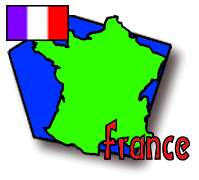Person of the Day: a dashing trio of hardworking French students
Place of the Day: Montpellier
Tech Fact of the Day: Football
Group Dispatch, June 8-9

Questions? Ask Anthony ![]() !
!
Return to Fast Facts
 |
 |
 |
 |
 |
|
Itinerary/ Journal |
Discussions |
About France |
eDscape Projects |
Scrapbook |
|
|
|
|
|
|
|
Copyright 1997-99 BikeAbout. All rights reserved.
